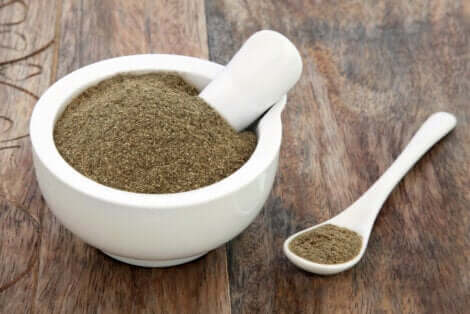Gymnema Sylvestre Properties and Contraindications


Reviewed and approved by the pharmacist Franciele Rohor de Souza
Gymnema Sylvestre is a woody climbing shrub that belongs to the Apocynaceae family. It comes from the tropical forests of India, Africa, and Australia. In addition, its leaves are well-known in the practice of Ayurvedic medicine. In fact, it’s also referred to as gurmar, a Hindi term that translates to “destroyer of sugar.” Keep reading to learn more about Gymnema Sylvestre properties and contraindications!
A publication in the Journal of Clinical Biochemistry and Nutrition states that the plant has gymnemic acids in it. These acids have anti-diabetic properties. In addition, it lowers the risk of heart disease and can helps you maintain a healthy weight.
Gymnema Sylvestre properties
Gymnema Sylvestre-based supplements have become popular all over the world. Due to their composition, Western medicine has become very interested in the plant.
In fact, it has been the source of several studies. So, although it’s not a first-line treatment, people recognize it for its ability to work against some health problems.
In addition, a study published in Frontier in Pharmacology highlights the fact that the plant contains chemical compounds with high therapeutic abilities. Some of those abilities include stigmasterol and triterpenoid saponins. These have the following properties:
- Anti-diabetic
- Hypoglycemic
- Antioxidants
- Anti-tumor
- Anti-fungal
- Hepatoprotective
Keep reading: Types of Antioxidants: Properties and Uses
Gymnema Sylvestre benefits
The main bioactive compounds in Gymnema Sylvestre are gymnemic acids. These, in addition to its phenolic compounds, saponins, and anthraquinones, give it a wide variety of positive health effects.

It decreases sugar cravings
Gymnema Sylvestre has the ability to reduce your sugar cravings. According to research published in Physiology & Behavior, gymnemic acid helps suppress sweetness by blocking sweet receptors on your taste buds.
That’s why this plant is great for those who constantly feel like to need to eat sugary foods. You can eat some extracts of this plant before your meals to limit how much you eat. In addition, it will keep you from eating as much sugar during or after your meals.
It helps regulate insulin
One of the most studied topics about Gymenma is the role it plays with conditions like diabetes and metabolic syndrome. A study from Diabetes, Obesity, and Metabolism shows that the plant helps to stimulate insulin production in the pancreas.
Specifically, its extracts can promote the regeneration of islet cells, which are responsible for producing insulin. As a result, your glucose levels drop and your overall health improves. However, experts are still doing more research to corroborate those findings.
It controls glucose levels
In addition to the previously mentioned Gymnema Sylvestre properties, we should also highlight its anti-diabetic properties. Consuming this plant helps reduce high levels of sugar in the blood. Also, people use it in combination with medications to enhance their effects.
However, in addition to stimulating insulin production, it also appears to help block receptors in the intestine. As a result, it helps to prevent glucose absorption. According to a study in Current Pharmaceutical Design, it’s necessary to take between 200 and 400 milligrams of gymnemic acid to decrease the intestinal absorption of sugar.
Remember, if you’re taking glucose-lowering medications, it’s important to talk to your doctor before you start taking any supplements. As of right now, experts say they still need to do more studies to evaluate the effects of this plant, as well as to look at its dosage amounts and levels of efficacy.
It has anti-inflammatory properties
The tannins and saponins in Gymnema leaves have great anti-inflammatory properties. Because of that, people use its extracts to help with inflammatory diseases, like diabetes, heart problems, and autoimmune diseases.
Weight loss: One of the properties of Gymnema Sylvestre
While it’s not an overnight miracle cure for weight loss, consuming Gymnema extracts can help decrease your body mass index.
In a study published in Diabetes, Obesity and Metabolism, people who took this supplement reduce their body weight by 5%.
In addition, the patients—who were moderately obese— decreased their food intake. Also, they had better control over their blood lipid levels.
It improves cardiovascular health
Consuming this plant’s extracts also has a positive effect on cardiovascular health. To be more exact, they’re useful for regulating lipids.
In this study from Diabetes, Obesity and Metabolism, they stated that Gymnema was useful for reducing triglycerides and bad cholesterol (LDL) in obese patients, 20.2% and 19% respectively. Therefore, many people believe it can reduce the risk of cardiovascular disease.
Discover: A Guide to Help You Watch Your Cholesterol Levels
Gymnema sylvestre contraindications
For most healthy adults, Gymnema Sylvestre is safe, as long as you only consume a moderate amount. However, given the lack of evidence on its safety, these are some of its contraindications:
- If you’re pregnant or breastfeeding
- For children and babies
- For patients with diabetes who are taking medications (unless approved by your doctor)
- Those who will undergo surgery soon
Although side effects are rare, they can also occur as a result of a sudden drop in blood sugar. Those side effects may include:
- Headache
- Dizziness or lightheadedness
- Instability
- Sickness

Gymnema Sylvestre consumption
Right now, there are Gymnema Sylvestre supplements available in powder, capsules, or tea. In addition, its leaves are great for homemade infusions and teas. The amount you consume will depend on the type of supplement you’re consuming and the brand.
However, in general, these are the amounts:
- 100-milligram capsules: 3 0r 4 times a day
- Cup of tea: 2 times a day
- 2 grams in powder, then you can increase to 4 grams if you don’t have any adverse reactions
Things to keep in mind about Gymnema Sylvestre
In Ayurvedic medicine, the Gymnema Sylvestre properties that are most valued are its ability to regulate glucose levels and reduce any risks associated with metabolic syndrome. Still, it shouldn’t be used as a first-line treatment for diabetes. In addition, it’s important to use it in moderation and under medical supervision.
Although some studies support its medicinal properties, the truth is that you shouldn’t use this plant as a replacement for conventional treatments. Instead, it should only be a supplement to promote well-being, and a doctor should authorize its use.
All cited sources were thoroughly reviewed by our team to ensure their quality, reliability, currency, and validity. The bibliography of this article was considered reliable and of academic or scientific accuracy.
- Kanetkar P, Singhal R, Kamat M. Gymnema sylvestre: A Memoir. J Clin Biochem Nutr. 2007 Sep;41(2):77-81. doi: 10.3164/jcbn.2007010. PMID: 18193099; PMCID: PMC2170951.
- Khan F, Sarker MMR, Ming LC, et al. Comprehensive Review on Phytochemicals, Pharmacological and Clinical Potentials of Gymnema sylvestre. Front Pharmacol. 2019;10:1223. Published 2019 Oct 29. doi:10.3389/fphar.2019.01223
- Leach MJ. Gymnema sylvestre for diabetes mellitus: a systematic review. J Altern Complement Med. 2007 Nov;13(9):977-83. doi: 10.1089/acm.2006.6387. PMID: 18047444.
- Khan F, Sarker MMR, Ming LC, et al. Comprehensive Review on Phytochemicals, Pharmacological and Clinical Potentials of Gymnema sylvestre. Front Pharmacol. 2019;10:1223. Published 2019 Oct 29. doi:10.3389/fphar.2019.01223
- Tiwari P, Mishra BN, Sangwan NS. Phytochemical and pharmacological properties of Gymnema sylvestre: an important medicinal plant. Biomed Res Int. 2014;2014:830285. doi:10.1155/2014/830285
-
Brala PM, Hagen RL. Effects of sweetness perception and caloric value of a preload on short term intake. Physiol Behav. 1983 Jan;30(1):1-9. doi: 10.1016/0031-9384(83)90030-6. PMID: 6836034.
-
Al-Romaiyan A, Liu B, Docherty R, Huang GC, Amiel S, Persaud SJ, Jones PM. Investigation of intracellular signalling cascades mediating stimulatory effect of a Gymnema sylvestre extract on insulin secretion from isolated mouse and human islets of Langerhans. Diabetes Obes Metab. 2012 Dec;14(12):1104-13. doi: 10.1111/j.1463-1326.2012.01660.x. Epub 2012 Aug 1. PMID: 22775778.
- Tiwari P, Ahmad K, Baig MH. Gymnema sylvestre for Diabetes: From Traditional Herb to Future’s Therapeutic. Curr Pharm Des. 2017;23(11):1667-1676. doi: 10.2174/1381612823666161108162048. PMID: 27834124.
- Ota A, Ulrih NP. An Overview of Herbal Products and Secondary Metabolites Used for Management of Type Two Diabetes. Front Pharmacol. 2017;8:436. Published 2017 Jul 6. doi:10.3389/fphar.2017.00436
This text is provided for informational purposes only and does not replace consultation with a professional. If in doubt, consult your specialist.








